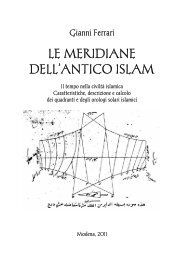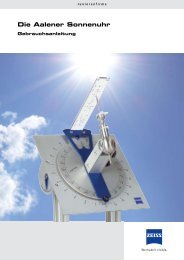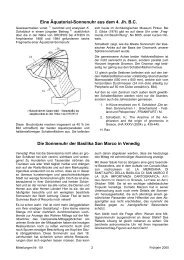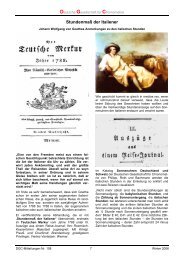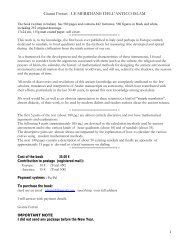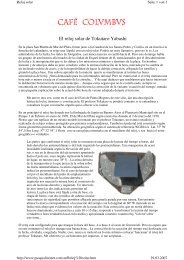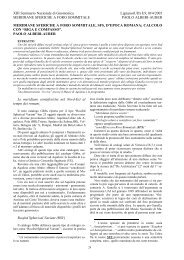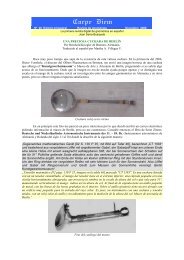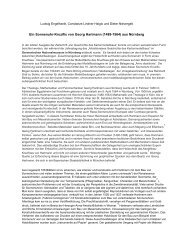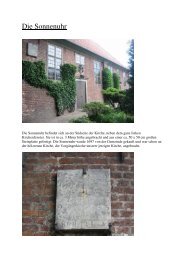International Gnomonic Bulletin - Gnomonica by Nicola Severino
International Gnomonic Bulletin - Gnomonica by Nicola Severino
International Gnomonic Bulletin - Gnomonica by Nicola Severino
Create successful ePaper yourself
Turn your PDF publications into a flip-book with our unique Google optimized e-Paper software.
(2) The second stop is Old Town Square (Staroměstské náměstí): continue <strong>by</strong> Jindřišská Street to<br />
Wenceslas Square (Václavské náměstí), turn right and walk down the square, via Na můstku and<br />
Melantrich Streets. 1 You should stop just in the front of the Prague Astronomical Clock (Pražský<br />
orloj).<br />
The instrument was manufactured in 1410 <strong>by</strong> Master Mikuláš of Kadaň, the designer was Jan<br />
Ondřejů, called Šindel (1375-1445). As with all middle-age clocks, it had to be equipped with a<br />
sundial to set the precise time. None has survived to today, but two dials were visible at the<br />
beginning of the 20 th century. They were installed during the reconstruction of the clock in 1790, led<br />
<strong>by</strong> the director of the Klementinum observatory Antonín Strnad (1749-1799), who probably was the<br />
designer of the sundials too. Even before, in the 16 th century, there were situated two sundials,<br />
positioned a little bit lower, at the level of the bottom dial, not at the level of the Apostles windows.<br />
What does the astronomical clock show? The hour finger, with a golden hand and a symbol of the<br />
Sun, shows (i) the Central European Time (on Roman numbers on the fixed dial), (ii) Italian hours,<br />
ie. time left from the sunset of the previous day (on Gothic numbers on the outer movable dial) and<br />
(iii) planetary hours (on the gold bows with black Arabic numbers). The last ones are of unequal<br />
length, because the time-span, when the Sun is above the horizon, is always divided to 12 parts,<br />
regardless of the different lengths of a "white" day in different seasons. The hand with a star shows<br />
the sidereal time (on the dial with Roman numbers). It is firmly connected with the gold eccentric<br />
circle - the ecliptic. The signs of zodiac, in which the Sun and the Moon are currently located, are<br />
clearly visible on the ecliptic. The symbol of the Sun is connected with both the hour hand and the<br />
circumference of the ecliptic, which rotates faster (approximately <strong>by</strong> 4 minutes per day). Thus the<br />
solar symbol orbits the ecliptic once per year. It is located nearer the dial center (ie. lower in the<br />
sky) during winter months and, to the contrary, farther away (ie. higher) during summer months.<br />
The area of the dial is divided into three coloured parts: the light blue denotes the daylight sky, the<br />
purple denotes nightfall and twilight, the black colour represents the night. All these help one to<br />
read the azimuths and altitudes of celestial bodies and the times of their rising and setting. The<br />
black field does not reach the dial border, which corresponds to the situation, that there is not an<br />
astronomical night does not set in out country during summer. One can also recognize the phase of<br />
the Moon. An ingenious mechanism inside the half silver-painted ball forces its rotation once per<br />
synodic month <strong>by</strong> daily motion of the hand with the Moon "upwards and downwards". There is a<br />
circular painted calendar below the astronomical clock. It rotates once per year and an arrow on the<br />
top indicates the current day.<br />
(3) Another dial, rather unusual, is a few tens of metres to the North-East from the clock - the<br />
Meridian of Prague is marked on the pavement. The Mariánský column, which stood in the middle<br />
of the square, served as a gnomon. Sadly, it was demolished in 1918, during the period when<br />
Czechoslovakia was founded.<br />
You may also visit the Týn Church, on the Eastern side of the square, where Tycho Brahe (1564-<br />
1601) is buried. His tomb is inside the church.<br />
(4) The highest concentration of sundials in the Czech Republic is surely at the Jesuit College of<br />
St. Clement (the Klementinum), now the housing of the National Library. Walk from the Prague<br />
clock West to the Small Square and turn right and then left to Linhart Street. Enter the main gate of<br />
the Klementinum.<br />
Only 3 out of the 5 courts are publicly accessible. You can see two East facing sundials through<br />
railings on the Economic Court (Hospodářský dvůr), at the third floor level. Another two South<br />
facing dials are barely visible. They are dated back to 1658-1662 (as inscriptions confirm) and their<br />
author was most probably Jesuit astronomer Valentin Stansel (1621-1705). Most of sundials are



